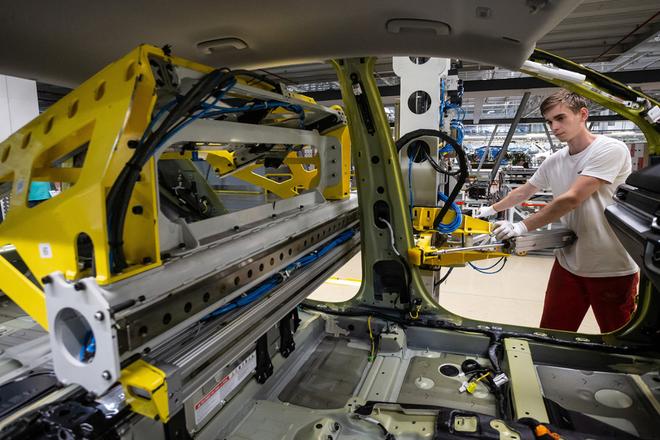The state budget deficit keeps deepening. The fiscal council, the Council for Budget Responsibility (RRZ), warns that public finances are in the high-risk zone, while achieving long-term sustainability would require a permanent increase in revenue or a reduction in expenditure in the billions of euros.
At the end of August, the state budget deficit amounted to €3.7 billion. This was €2.2 billion or 145 percent more compared to the same period the previous year.
The state budget’s revenues amounted to €13.686 billion at the end of August, up €1.763 billion or 14.8 percent year-on-year. However, budget expenditures increased by a doubled pace year-on-year, by 29.6 percent or €3.976 billion to €17.416 billion.

Calls for consolidation
The long-term sustainability of public finances has significantly deteriorated since the outbreak of the war in Ukraine. Achieving long-term sustainability would require a permanent increase in revenue or a reduction in the expenditure of €7.6 billion, the Council for Budget Responsibility cited in its memo.
The debt-to-GDP ratio was above the highest, the fifth sanction band of the debt brake in 2021 and 2022. Debt reached 61 percent of GDP at the end of 2021, based on data published by Eurostat in October 2022, and 57.8 percent of GDP at the end of 2022, based on provisional data from April 2023.
Despite the high levels of government debt, which have been continuously above the highest debt brake sanction band since 2020, the sanctions are only formally met, with minimal impacts on reducing the general government debt.
“The debt brake alone, without spending limits, did not provide sufficient protection for the long-term health of public finances,” said Ján Tóth, head of the fiscal council. “That is why the modernisation of the constitutional law, including the alignment of the debt brake sanctions with the recently adopted spending limits, is crucial and should not be delayed.”
The effective implementation of spending limits should also contribute to improving long-term sustainability.
“However, it should be added that in the coming years, the implementation of spending limits alone at the legally required level of deficit improvement will not be sufficient to stabilise the debt in the medium term, so the consolidation of public finances in the coming years should be more ambitious than the minimum required by the law,” opines the fiscal council.
Slovak economic growth endangered by external factors
Slovakia’s GDP in the second quarter of 2023 increased by 1.5 percent year-on-year (in fixed prices, not seasonally adjusted). The volume of GDP in current prices increased by 11.3 percent in yearly terms, reaching €30.3 billion. Seasonally adjusted, the country's GDP grew by 0.4 percent quarter-on-quarter, based on data of the Statistics Office published on September 5.
Economic growth was again mainly driven by automotive production, noted Ľubomír Koršňák, UniCredit Bank analyst Ľubomír Koršňák in his commentary on the economic growth.
“A look at GDP from the supply side confirms that the surprisingly strong GDP figures in Slovakia in the second quarter (when compared to the rest of the region and Europe) were mainly driven by Slovak automotive plants,” he wrote in his memo. “These benefited from an easing of bottlenecks and still unsatisfied domestic (European) demand that had accumulated in previous years - during the pandemic and the semiconductor crisis.”
However, he said that the prospects for the external environment into the second half of the year are increasingly worrying, mostly due to weak figures for the German economy, a key business partner of Slovakia’s industry for a long time.
Another concern is the deteriorating mood in the Slovak and European economy, which has its roots in industry. Skepticism is increasingly spreading to the service sector as well. Koršňák expects only a moderate acceleration in GDP growth to 1.6 percent next year,” he wrote in the memo.
“However, the outcome of the general election could have a significant impact on growth next year, as it will determine the extent and method employed for the necessary consolidation of public finances,” noted Koršňák.
Based on the spending limits, the government is supposed to permanently reduce the deficit by half a percent of the GDP or about €600 million per year.
Fixing public finances is not a big issue for politicians ahead of the September elections. They admit that Slovakia has a high budget deficit and that it needs some consolidation, but they are less specific about what exactly they would do if they became part of the next government.
They do not want to raise taxes on labour or cut social benefits and pensions. Only some allow more taxation on consumption or on banks and monopolies. Several parties say that they want to promote economic growth, which they believe would help with the consolidation of public finances. They talk of supporting the business sector and of transferring resources from the central level to the regions, the Denník N wrote, based on its survey among political parties with prospects to be elected in parliament.


 A worker at the Kia Slovakia car plant in Žilina on June 30, 2023. (source: TASR - Daniel Stehlík)
A worker at the Kia Slovakia car plant in Žilina on June 30, 2023. (source: TASR - Daniel Stehlík)